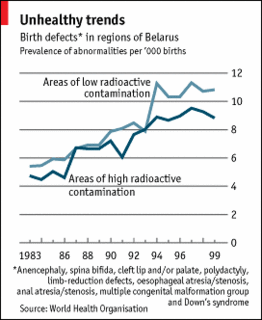Nuclear power | Little to fear but fear itself | Economist.com

Nuclear power Little to fear but fear itself Economist.com
Little to fear but fear itself
Sep 8th 2005
From The Economist print edition
Chernobyl's legacy
IN 1986 the Ukrainian town of Chernobyl was the site of the world's worst nuclear power-plant accident. Almost 30 people died from radiation sickness in the immediate aftermath, and several hundred were hospitalised. Millions more were exposed to radiation from the plant, and 350,000 were permanently evacuated from their homes. But the tens of thousands of premature deaths predicted by some—and expected by many of those exposed—have failed to materialise. That is good news. The bad news is that the expected legacy of deaths from cancer has turned into a real legacy of “paralysing fear”.
That, at least, is the conclusion of a newly published report compiled by the Chernobyl Forum, a group of several hundred scientists, economists and health experts supported by the three governments involved—those of Ukraine, Russia and Belarus—and by the United Nations. The forum is not sanguine. It observed a rise in cancers such as leukaemia in the most highly exposed emergency and recovery workers. And although tens of thousands of deaths have not materialised, it does predict that 4,000 people will eventually die from cancer attributable to exposure from radiation leaked from the plant. But while that sounds a lot, it would represent an increase of only about 3% in the number of cancer-related deaths among the 600,000 emergency workers, evacuees and residents of contaminated areas originally identified as being at risk. That is because about a quarter of these people would be expected to die from cancer even had they not been exposed to Chernobyl's radiation. On top of that, one of the biggest worries at the time of the accident—thyroid cancer—did not prove as bad as feared. Although 4,000 children contracted it by drinking contaminated milk, only nine died. As for the 5m people who still live in contaminated areas, most have exposures to radiation that remain within the recommended dose limit. Only 100,000 of them receive more than they should.
The forum's members were unable to examine all the potential effects of Chernobyl's radiation, says Fred Mettler, a professor of nuclear medicine at the University of New Mexico who led the team investigating health effects for the Chernobyl Forum. They picked the ones they thought most important. Some researchers, for example, think radiation can cause diabetes. However, the data were not sufficiently good to examine this theory.
Perhaps the true tragedy of Chernobyl is that the biggest observable health impact so far has been on the mental health of the millions who have been told they are at risk. Many of these people received radiation doses no larger than they would get on a holiday in a place such as Denver, where the altitude increases exposure to cosmic rays, yet they have spent their lives anticipating illness and incapacity, and this has translated into such undesirable behaviours as drug abuse and long-term dependency on the state.
High on the list of things that need to be done, therefore, is to change assistance programmes that foster a victim mentality. Instead, people need reassurance that they have not been harmed by radiation. For example, says Dr Mettler, many now wonder if they can safely have children.
The answer is that they can—or, at least, if they cannot, it is nothing to do with Chernobyl. Although the rate of birth defects is increasing in Belarus, the rise is happening in both contaminated and uncontaminated areas. In fact, the data (see chart) show that unexposed areas actually have a higher rate of congenital abnormalities, so whatever is causing the rise is unlikely to be connected with the accident.

0 Comments:
Post a Comment
<< Home